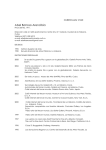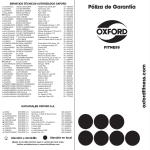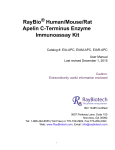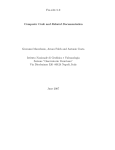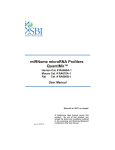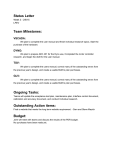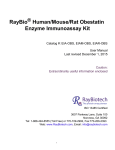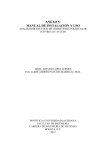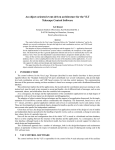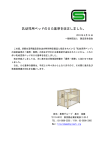Download DRG Apelin C-Terminus Elisa (Human/Mouse/Rat) (EIA
Transcript
DRG® Apelin C-Terminus Elisa (Human/Mouse/Rat) (EIA-5178) Revised 3 Aug. 2011 rm (Vers. 2.1) USA: RUO This kit is intended for Research Use Only. Not for use in diagnostic procedures. Please use only the valid version of the package insert provided with the kit. 1 INTRODUCTION Apelin-C Terminus Enzyme Immunoassay (EIA) Kit is designed to target the C-terminus of the 77-aa apelin peptide, thus the active forms of Apelin including Apelin-36 and Apelin 13 can be detected. 2 GENERAL DESCRIPTION The Apelin-C Terminus Enzyme Immunoassay (EIA) Kit is for detecting Apelin-C Terminus peptide based on the principle of Competitive Enzyme Immunoassay. The microplate in the kit is pre-coated with anti-rabbit secondary antibody. After a blocking step and incubation of the plate with anti-Apelin-C Terminus antibody, both biotinylated Apelin-C Terminus peptide and peptide standard or targeted peptide in samples interacts competitively with the Apelin-C Terminus antibody. Uncompeted (bound) biotinylated Apelin-C Terminus peptide then interacts with Streptavidin-horseradish peroxidase (SA-HRP) which catalyzes a color development reaction. The intensity of colorimetric signal is directly proportional to the amount of biotinylated peptide-SA-HRP complex and inversely proportional to the amount of Apelin-C Terminus peptide in the standard or samples. This is due to the competitive binding to Apelin-C Terminus antibody between biotinylated ApelinC Terminus peptide and peptides in standard or samples. A standard curve of known concentration of Apelin-C Terminus peptide can be established and the concentration of Apelin-C Terminus peptide in the samples can be calculated accordingly. 3 REAGENTS 1. Apelin-C Terminus Microplate (Item A): 96 wells (12 strips x 8 wells) coated with secondary antibody. 2. Wash Buffer Concentrate (20x) (Item B): 25 ml 3. Standard Apelin-C Terminus Peptide (Item C): 2 vials, 10 µl/vial 4. Anti-Apelin-C Terminus polyclonal antibody (Item N): 2 vials, 5 µl/vial 5. Assay Diluent A (Item D): 30 ml, contains 0.09% sodium azide as preservative. For Standard/Sample (serum/plasma) diluent. 6. Assay Diluent B (Item E): 15 ml of 5x concentrated buffer. For Standard/Sample (cell culture medium/urine) diluent. 7. Biotinylated Apelin-C Terminus peptide, (Item F): 2 vials, 20 µl/vial 8. HRP-Streptavidin concentrate (Item G): 8 µl, 5,000 X concentrated HRP-conjugated Streptavidin. 9. Positive control (Item M): 1 vial, 100 µl/vial DRG International, Inc., USA Fax: (908) 233 0758 e-mail: [email protected] 1 DRG® Apelin C-Terminus Elisa (Human/Mouse/Rat) (EIA-5178) Revised 3 Aug. 2011 rm (Vers. 2.1) USA: RUO 10. TMB One-Step Substrate Reagent (Item H): 12 ml of 3, 3’, 5, 5’¬tetramethylbenzidine (TMB) in buffered solution. 11. Stop Solution (Item I): 8 ml of 2 M sulfuric acid. 12. Assay Diagram (Item J). 13. User Manual (Item K) 4 STORAGE Standard, Biotinylated Apelin-C Terminus peptide, and positive control should be stored at -20 °C or -80 °C (recommended at –80 °C) after arrival. Avoid multiple freeze-thaws. Opened Microplate Wells and antibody may be stored for up to 1 month at 2 °C to 8 °C. Return unused wells to the pouch containing desiccant pack, reseal along entire edge. Avoid multiple freeze-thaws for Standard, Biotinylated Apelin-C Terminus peptide and positive control. If stored in this manner, the kit is warranteed for 6 months from the date of shipment. 5 1. 2. 3. 4. 5. 6. 7. 8. 9. 10. 11. ADDITIONAL MATERIALS REQUIRED Microplate reader capable of measuring absorbance at 450 nm. Precision pipettes to deliver 2 µl to 1 ml volumes. Adjustable 1-25 ml pipettes for reagent preparation. 100 ml and 1 liter graduated cylinders. Absorbent paper. Distilled or deionized water. SigmaPlot software (or other software which can perform four-parameter logistic regression models) Tubes to prepare standard or sample dilutions. Orbital shaker Aluminum foil Saran Wrap 6 REAGENT PREPARATION If testing plasma or serum samples, use Assay Diluent A to dilute Item F and Item C. If testing cell culture media or other sample types, use Assay Diluent B to dilute Item F and Item C. For sample and positive control dilutions, refer to steps 6, 7, 8 and 10 of Reagent Preparation. 1. Keep kit reagents on ice during reagent preparation steps. Equilibrate plate to room temperature before opening the sealed pouch. 2. Assay Diluent B (Item E) should be diluted 5-fold with deionized or distilled water. 3. Briefly centrifuge the Anti-Apelin C-Terminus Antibody vial (Item N) before use. Add 50 µl of 1x Assay Diluent B into the vial to prepare a detection antibody concentrate. Pipette up and down to mix gently. 4. The antibody concentrate should then be diluted 100-fold with 1x Assay Diluent B. This is your anti-Apelin CTerminus antibody working solution, which will be used in step 2 of the Assay Procedure. DRG International, Inc., USA Fax: (908) 233 0758 e-mail: [email protected] 2 DRG® Apelin C-Terminus Elisa (Human/Mouse/Rat) (EIA-5178) Revised 3 Aug. 2011 rm (Vers. 2.1) USA: RUO NOTE: the following steps may be done during the antibody incubation procedure (step 2 of Assay Procedure). 5. Briefly centrifuge the vial of Biotinylated Apelin C-Terminus (Item F) before use. Add 5 µl of Item F to 5 ml of the appropriate Assay Diluent. Pipette up and down to mix gently. The final concentration of biotinylated Apelin CTerminus will be 50 ng/ml. This solution will only be used as the diluent in step 6 of Reagent Preparation. 6. Preparation of Standards: Label 6 microtubes with the following concentrations: 1000 ng/ml, 100 ng/ml, 10 ng/ml, 1 ng/ml, 100 pg/ml and 0 pg/ml. Pipette 450 µl of biotinylated Apelin C-Terminus solution into each tube, except for the 1000 ng/ml (leave this one empty). It is very important to make sure the concentration of biotinylated Apelin CTerminus is 50 ng/ml in all standards. a. Briefly centrifuge the vial of Apelin C-Terminus (Item C). In the tube labeled 1000 ng/ml, pipette 8 µl of Item C and 792 µl of 50 ng/ml biotinylated Apelin C-Terminus solution (prepared in step 5 above). This is your Apelin C-Terminus stock solution (1000 ng/ml Apelin C-Terminus, 50 ng/ml biotinylated Apelin CTerminus). Mix thoroughly. This solution serves as the first standard. b. To make the 100 ng/ml standard, pipette 50 µl of Apelin C- Terminus stock solution the tube labeled 100 ng/ml. Mix thoroughly. c. Repeat this step with each successive concentration, preparing a dilution series as shown in the illustration below. Each time, use 450 µl of biotinylated Apelin C-Terminus and 50 µl of the prior concentration until 100 pg/ml is reached. Mix each tube thoroughly before the next transfer. d. The final tube (0 pg/ml Apelin C-Terminus, 50 ng/ml biotinylated Apelin C-Terminus) serves as the zero standard (or total binding). 7. Prepare a 10-fold dilution of Item F. To do this, add 2 µl of Item F to 18 µl of the appropriate Assay Diluent. This solution will be used in steps 8 and 10. 8. Positive Control Preparation: briefly centrifuge the positive control vial (Item M). To the tube of Item M, add 101 µl 1x Assay Diluent B. Also add 4 µl of 10-fold diluted Item F (prepared in step 7) to the tube. This is a 2-fold dilution of the positive control. Mix thoroughly. The positive control is a cell culture medium sample with an expected signal between 10% and 30% of total binding (70-90% competition) if diluted as described above. It may be diluted further if desired, but be sure the final concentration of biotinylated Apelin C-Terminus is 50 ng/ml. 9. If Item B (20X Wash Concentrate) contains visible crystals, warm to room temperature and mix gently until dissolved. Dilute 20 ml of Wash Buffer Concentrate into deionized or distilled water to yield 400 ml of 1X Wash Buffer. 10. Sample Preparation: Use Assay Diluent A + biotinylated Apelin f C-Terminus to dilute serum/plasma samples. For cell culture j medium and other sample types, use 1X Assay Diluent B + biotinylated Apelin C-Terminus as the DRG International, Inc., USA Fax: (908) 233 0758 e-mail: [email protected] 3 DRG® Apelin C-Terminus Elisa (Human/Mouse/Rat) (EIA-5178) Revised 3 Aug. 2011 rm (Vers. 2.1) USA: RUO diluent. It is very important to make sure the final concentration of the biotinylated Apelin C-Terminus is 50 ng/ml in every sample. EXAMPLE: to make a 4-fold dilution of sample, mix together 2.5 µl of 10-fold diluted Item F (prepared in step 7), 185 µl o f appropriate Assay Diluent, and 62.5 µl of your sample; mix gently. The total volume is 250 µl, enough for duplicate wells on the microplate. Do not use Item F diluent from Step 5 for sample preparation. If you plan to use undiluted samples, you must still add biotinylated Apelin C-Terminus to a final concentration of 50 ng/ml. EXAMPLE: Add 5 µl of 10-fold diluted Item F to 245 µl of sample. NOTE: Optimal sample dilution factors should be determined empirically, however you may contact technical support to obtain the recommended dilution ranges for serum or plasma. 11. Briefly centrifuge the HRP-Streptavidin vial (Item G) before use. The HRP-Streptavidin concentrate should be diluted 5,000-fold with 1X Assay Diluent B. For example: For a 5000-fold Dilution of HRP-Streptavidin solution, briefly spin the vial (Item G) and pipette up and down to mix gently . Add 2 µl of HRP-Streptavidin concentrate into a tube with 198 µl 1X Assay Diluent B to prepare a 100-fold diluted HRP-Streptavidin solution (do not store the diluted solution for next day use). Mix thoroughly and then pipette 100 µl of prepared 100-fold diluted solution into a tube with 4.9 ml 1x Assay Diluent B to prepare a final 5000-fold diluted HRP- Streptavidin solution. Note: Do not use Assay Diluent A for HRP-Streptavidin preparation in Step 11. 7 ASSAY PROCEDURE 1. Keep kit reagents on ice during reagent preparation steps. It is recommended that all standards and samples be run at least in duplicate. 2. Add 100 µl anti-Apelin C-Terminus antibody (see Reagent Preparation step 4) to each well. Incubate for 1.5 hours at room temperature with gentle shaking (1-2 cycles/sec). You may also incubate overnight at 4°C. 3. Discard the solution and wash wells 4 times with 1x Wash Buffer (200-300 µl each), Washing may be done with a multichannel pipette or an automated plate washer. Complete removal of liquid at each step is essential to good assay performance. After the last wash, remove any remaining Wash Buffer by aspirating or decanting. Invert the plate and blot it against clean paper towels. 4. Add 100 µl of each standard (see Reagent Preparation step 7), positive control (see Reagent Preparation step 8) and sample (see Reagent Preparation step 10) into appropriate wells. Be sure to include a blank well (Assay Diluent only). Cover wells and incubate for 2.5 hours at room temperature with gentle shaking (1-2 cycles/sec) or overnight at 4°C. 5. Discard the solution and wash 4 times as directed in Step 3. 6. Add 100 µl of prepared HRP-Streptavidin solution (see Reagent Preparation step 11) to each well. Incubate for 45 minutes at room temperature. It is recommended that incubation time should not be shorter or longer than 45 minutes. 7. Discard the solution and wash 4 times as directed in Step 3. 8. Add 100 µl of TMB One-Step Substrate Reagent (Item H) to each well. Incubate for 30 minutes at room temperature in the dark with gentle shaking (1-2 cycles/sec). 9. Add 50 µl of Stop Solution (Item I) to each well. Read absorbances at 450 nm immediately. DRG International, Inc., USA Fax: (908) 233 0758 e-mail: [email protected] 4 DRG® Apelin C-Terminus Elisa (Human/Mouse/Rat) (EIA-5178) Revised 3 Aug. 2011 rm (Vers. 2.1) USA: RUO 8 ASSAY PROCEDURE SUMMARY 1. Prepare all reagents, samples and standards as instructed. ↓ 2. Add 100 µl anti-Apelin C-Terminus antibody to each well. Incubate 1.5 hours at room temperature or overnight at 4°C. ↓ 3. Add 100 µl standard or sample to each well. Incubate 2.5 hours at room temperature or overnight at 4°C. ↓ 4. Add 100 µl prepared streptavidin solution. Incubate 45 minutes at room temperature. ↓ 5. Add 100 µl TMB One-Step Substrate Reagent to each well. Incubate 30 minutes at room temperature. ↓ 6. Add 50 µl Stop Solution to each well. Read at 450 nm immediately 9 CALCULATION OF RESULTS Calculate the mean absorbance for each set of duplicate standards, controls and samples, and subtract the blank optical density. Plot the standard curve using SigmaPlot software (or other software which can perform four-parameter logistic regression models), with standard concentration on the x-axis and percentage of absorbance (see calculation below) on the y-axis. Draw the best-fit straight line through the standard points. 10 ASSAY PROCEDURE SUMMARY 1. Prepare all reagents, samples and standards as instructed. 2. Add 100 µl anti-Apelin-C Terminus antibody (1000X dilution) to each well Incubate 1.5 hours at room temperature. 3. Add 100 µl standard peptides or sample mixed with biotinylated Apelin-C Terminus peptide to each well. Incubate 2.5 hours at room temperature or overnight at 4 °C. 4. Add 100 µl prepared Streptavidin solution. Incubate 45 minutes at room temperature. 5. Add 100 µl TMB One-Step Substrate Reagent to each well. Incubate 30 minutes at room temperature. 6. Add 50 µl Stop Solution to each well. Read at 450 nm immediately 11 CALCULATION OF RESULTS Calculate the mean absorbance for each set of duplicate standards, controls and samples, and subtract the blank optical density. Plot the standard curve using SigmaPlot software (or other software which can perform four-parameter logistic regression models), with standard concentration on the x-axis and percentage of absorbance (see calculation below) on the y-axis. Draw the best-fit straight line through the standard points. DRG International, Inc., USA Fax: (908) 233 0758 e-mail: [email protected] 5 DRG® Apelin C-Terminus Elisa (Human/Mouse/Rat) (EIA-5178) Revised 3 Aug. 2011 rm (Vers. 2.1) USA: RUO Percentage absorbance = (B – blank OD) / (B0 – blank OD) where B = OD of sample or standard and B0 = OD of zero standard (total binding) 11.1 TYPICAL DATA These standard curves are for demonstration only. A standard curve must be run with each assay. 12 REFERENCES / LITERATURE 1. Principe A, Melgar-Lesmes P, Fernández-Varo G, Del Arbol LR, Ros J, Morales-Ruiz M, Bernardi M, Arroyo V, Jiménez W (2008). "The hepatic apelin system: A new therapeutic target for liver disease". Hepatology 48 (4): 11931201. 2. Lee DK, George SR, O'Dowd BF (2006). "Unravelling the roles of the apelin system: prospective therapeutic applications in heart failure and obesity". Trends Pharmacol. Sci. 27 (4): 190–4. 3. Lee DK, Saldivia VR, Nguyen T, Cheng R, George SR, O'Dowd BF (2005). "Modification of the terminal residue of apelin-13 antagonizes its hypotensive action". Endocrinology 146 (1): 231–6. 4. Lee DK, Lança AJ, Cheng R, Nguyen T, Ji XD, Gobeil F, Chemtob S, George SR, O'Dowd BF (2004). "Agonistindependent nuclear localization of the Apelin, angiotensin AT1, and bradykinin B2 receptors". J. Biol. Chem. 279 (9): 7901–8. 5. Lee DK, Cheng R, Nguyen T, Fan T, Kariyawasam AP, Liu Y, Osmond DH, George SR, O'Dowd BF (2000). "Characterization of apelin, the ligand for the APJ receptor". J. Neurochem. 74 (1): 34–41. 6. Tatemoto K, Hosoya M, Habata Y, Fujii R, Kakegawa T, Zou MX, Kawamata Y, Fukusumi S, Hinuma S, Kitada C, Kurokawa T, Onda H, DRG International, Inc., USA Fax: (908) 233 0758 e-mail: [email protected] 6 DRG® Apelin C-Terminus Elisa (Human/Mouse/Rat) (EIA-5178) Revised 3 Aug. 2011 rm (Vers. 2.1) USA: RUO 13 TROUBLESHOOTING GUIDE Problem 1. Poor standard curve Cause 1. Inaccurate pipetting Solution 1. Check pipettes 2. Improper standard dilution 2. Ensure briefly spin the vial of Item C and dissolve the powder thoroughly by a gentle mix. 1. Too brief incubation times 1. Ensure sufficient incubation time; assay procedure step 2 change to over night 2. Inadequate reagent volumes or improper dilution 2. Check pipettes and ensure correct preparation 3. Large CV 1. Inaccurate pipetting 1. Check pipettes 4. High background 1. Plate is insufficiently washed 1. Review the manual for proper wash. If using a plate washer, check that all ports are unobstructed. 2. Contaminated wash buffer 2. Make fresh wash buffer 1. Improper storage of the EIA kit 1. Store your standard at<-20 °C after reconstitution, others at 4 °C. Keep substrate solution protected from light 2. Low signal 5. Low sensitivity 2. Stop solution 2. Stop solution should be added to each well before measure VERSION_07-01-11~RM DRG International, Inc., USA Fax: (908) 233 0758 e-mail: [email protected] 7







